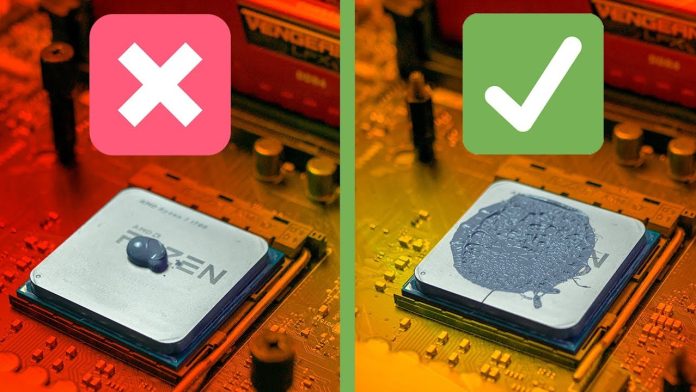When discussing different computer components, one often overlooks the importance of thermal paste. However, thermal paste plays a pivotal role in maintaining your computer’s functionality. A thermal paste issue can lead to computer damage and hinder your work. In this guide, we will delve into how to safely clean thermal paste and reapply it. We will also explore why thermal paste is crucial for your computer and provide essential tips for selecting the right thermal paste for your system.
What Is Thermal Paste?
Thermal paste, also known as thermal compound or TIM(Thermal Interface Material), is a paste applied to the CPU to prevent overheating. It’s primary purpose is to enhance heat transfer between a computer’s integrated heat spreader and heat sink, ensuring your computer remains cool. It addresses microscopic imperfections on contact surfaces, eliminating air pockets and facilitating heat distribution from the CPU to the heat sink.
Why Is Thermal Paste So Important?
In simple terms, thermal paste keeps your CPU cool. Computers are designed for heavy workloads, often running for extended periods. If the CPU overheats during prolonged usage, it can damage the processor and disrupt your work. Absence of thermal paste increases the risk of CPU overheating, leading to functionality issues and reducing the overall lifespan of your computer.
Over time, thermal paste can dry out, resulting in a significant drop in computer performance, particularly when running resource-intensive applications. It may cause system hangs, abrupt restarts and hindered functionality. In such cases, cleaning the old, dried-out thermal paste from your CPU and reapplying it is necessary, a task that you can undertake with proper guidance and knowledge.
How Often Should You Clean and Reapply Thermal Paste?
The frequency of thermal paste replacement depends on your computer usage and the quality of the thermal paste. Generally, it’s advisable to reapply thermal paste every 3 to 5 years or when:
- You experience issues associated with poor thermal paste application.
- Your CPU operates at higher temperatures than normal.
- You need to remove the CPU cooler for any reason.
With these considerations in mind, let’s proceed to the step-by-step guide on cleaning thermal paste off your CPU and reapplying it.
Step-by-Step Guide: How to Clean Thermal Paste Off CPU and Reapply
Step 1: Gather Your Supplies
Before cleaning thermal paste from your CPU, ensure you have the necessary supplies ready:
- 90% or higher isopropyl alcohol(99% recommended)
- Thermal paste
- Microfiber cloths
- Thermal paste cleaning product(optional)
Ensure your workspace is clean, organized and free of lint, dust, or debris.
Step 2: Remove the CPU Cooler
To access your CPU, you must first remove the CPU cooler:
Let your computer run for approximately 15 to 20 minutes. This softens the thermal paste, making it easier to remove.
- Note: Cold thermal paste can bond the CPU and heat sink, increasing the risk of damage during removal.
Power off your computer and unplug all cords, including the CPU cooler power cord.
Carefully loosen the cooler bolts following the cooler’s manual.
Gently twist the cooler back and forth to loosen it.
- Note: Do not pull up the heat sink during this process to avoid damaging CPU pins.
Non-stock coolers may be easier to remove.
- If the heatsink remains stuck, run your computer for about an hour before retrying.
Step 3: Clean the Thermal Paste Off Your CPU
- Use a dry microfiber cloth to gently remove chunks of old thermal paste.
- Apply a small amount of isopropyl alcohol or thermal paste cleaner to the cloth and wipe your CPU from top to bottom. Ensure gentle and slow movements to prevent CPU damage. Pay attention to cleaning around the edges.
- Allow the CPU to dry during this process.
Step 4: Clean the Heat Sink
After cleaning the thermal paste from your CPU, apply the same cleaning process to your heat sink.
Step 5: Reapply Thermal Paste
With both CPU and heat sink cleaned, it’s time to reapply thermal paste:
- Squeeze a small amount of thermal paste directly onto the center of your CPU.
- Carefully place the heat sink back onto the CPU, ensuring a flat connection for even paste distribution.
- Reattach the CPU cooler and secure it firmly.
Tips for This Step:
- Be cautious: If the cooler slips or shifts, restart the process. Slippage can disrupt the seal and create air pockets, compromising thermal paste effectiveness.
- Use the right amount: Avoid applying too little or too much paste. Proper application is crucial; use your senses to gauge the appropriate quantity.
Step 6: Check the CPU Temperature
After applying thermal paste, monitor your CPU’s temperature. You can use tools like Intel XTU or BIOS to check it. The ideal temperature range is between 60°C to 70°C(or 70°C to 80°C for overclocked CPUs). If your CPU exceeds 80°C, seek professional assistance.
How to Clean Thermal Paste Off CPU Socket Pins?
In rare cases, thermal paste can spill onto CPU socket pins. If this occurs, follow these steps carefully to clean them without damaging the fragile pins:
- Use a soft-bristled toothbrush.
- Dip the toothbrush into 90%+ isopropyl alcohol.
- Brush the pins gently in the same direction as the pins point.
- Wipe the pins with a dry microfiber cloth.
- Allow the CPU socket pins to dry for about an hour.
How to Clean Thermal Paste Off PGA Socket?
If thermal paste enters a PGA socket(Pin Grid Array), follow these steps for both types of PGA sockets:
Pin Grid Array(PGA):
- Dip a soft-bristled toothbrush into isopropyl alcohol.
- Brush gently across the pins in the same direction as the pins point.
- Wipe with a dry microfiber cloth.
- Allow the socket to dry for about an hour.
Land Grid Array(LGA):
- Use isopropyl alcohol to wipe the paste off the surface gently in a straight line.
- Repeat, using a new wipe each time.
- Allow it to dry for an hour.
Things to Consider When Buying Thermal Paste
When purchasing thermal paste, keep the following factors in mind:
Viscosity: Choose thermal paste with higher viscosity, as it is easier to apply and adheres better.
Thermal Conductivity Rating: Look for a high thermal conductivity rating for better heat transfer.
Volume: Buy the appropriate amount, as thermal paste typically cannot be reused.
Type: Select between conductive and non-conductive thermal paste based on your knowledge and experience. Conductive paste is best suited for experienced users.
Frequently Asked Questions
-
Does Thermal Paste Application Method Matter?
While there are various application methods(pea, line, X), the exact method matters less than applying the right amount of paste. The key is to apply an appropriate quantity in the center of your CPU to ensure optimal performance.
-
How Long Does Unused Thermal Paste Last?
Unused thermal paste typically has a shelf life of around 5 years, depending on the brand and manufacturing date.
-
Can Nail Polish Remover Be Used to Remove Thermal Paste?
Nail polish remover contains additional contaminants like fragrance oils, making it unsuitable for cleaning thermal paste.
-
Can Paper Towels Be Used Instead of Microfiber Cloth?
Paper towels can leave lint behind. If a microfiber cloth is unavailable, consider using coffee filter paper as an alternative.
-
How to Keep the Computer Cool?
Regularly clean clogged fans, ensure adequate airflow and place your computer in a well-ventilated area to maintain optimal cooling.
Conclusion
By following this comprehensive guide, you can safely clean thermal paste off your CPU and reapply it, enhancing your computer’s performance and prolonging it’s lifespan. If you lack experience or confidence, seek professional assistance to avoid any potential damage.
Experiencing difficulties with your Device, check out our “How To” page on how to resolve some of these issues.














